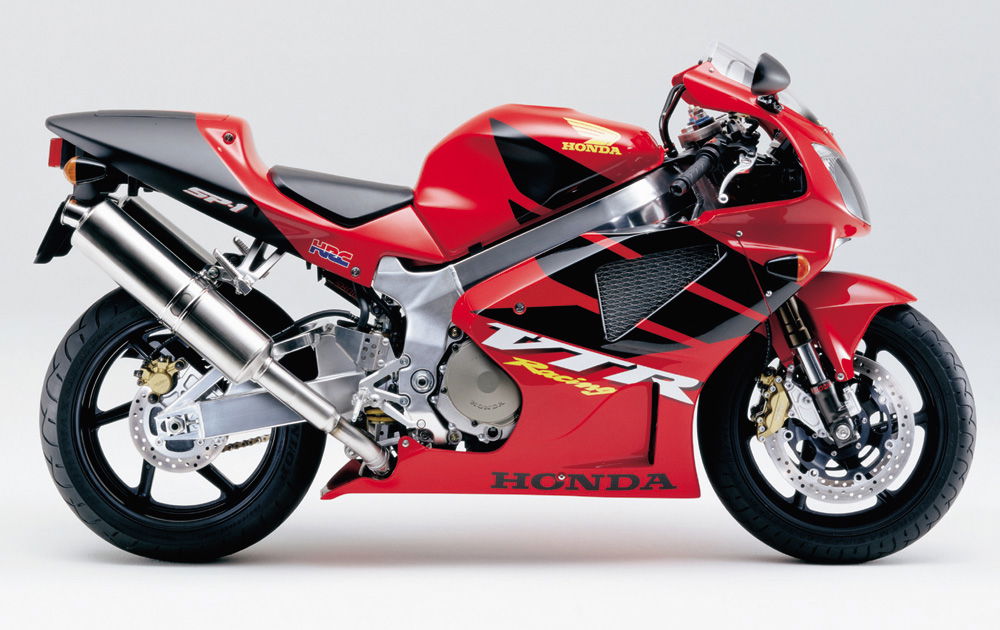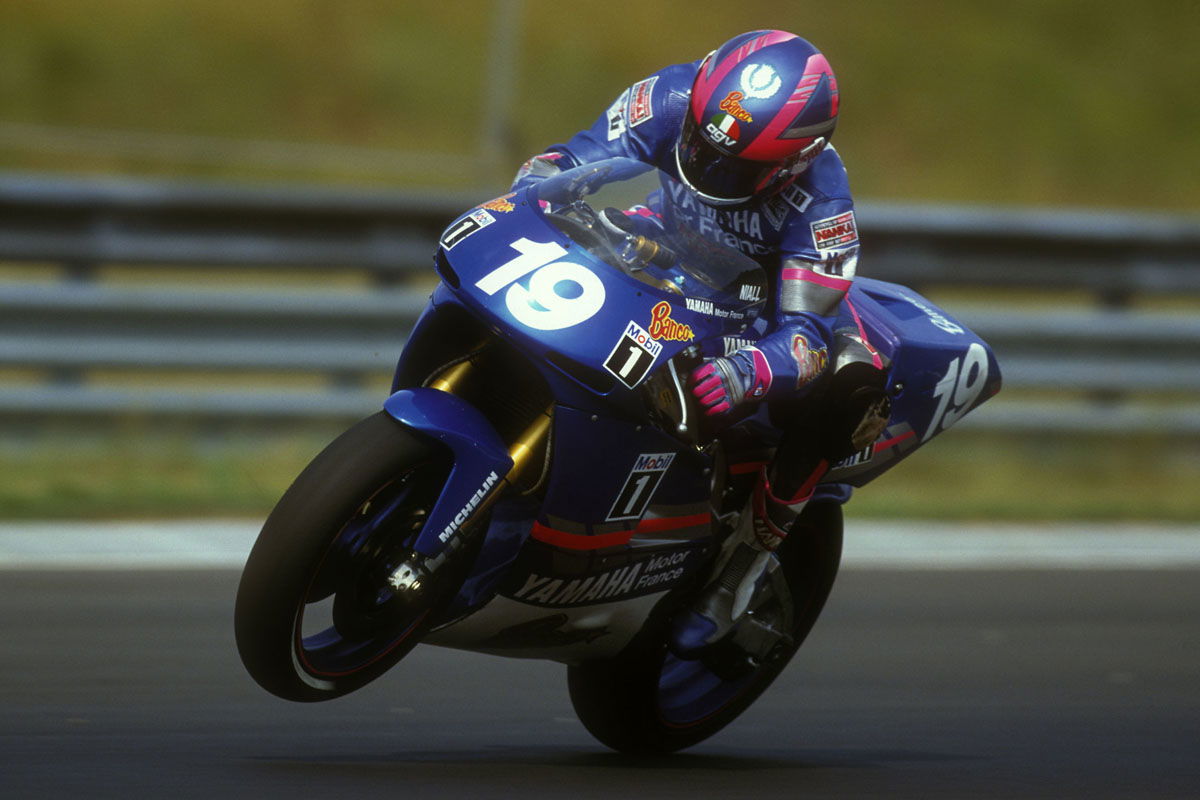My Oulton Park Triumph Triple Challenge
A one-off ride on a Daytona 675 at Oulton Park. It's what dreams are made of.
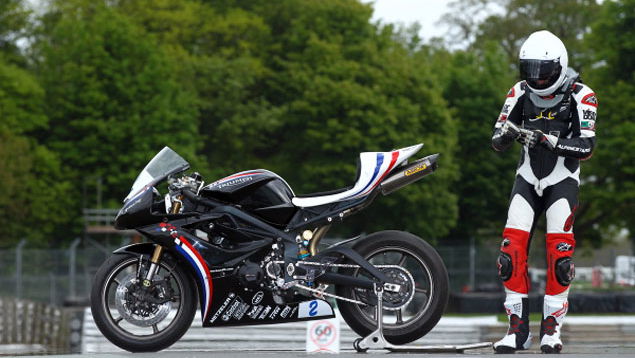
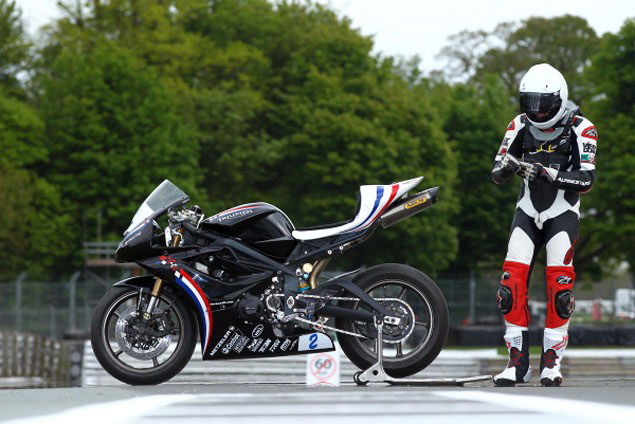
Pictures: DoubleRed.co.uk
Triumph’s Daytona 675 and a race track. It sounds like a match made in heaven.
It is, usually.
What if that match was taking place at a track you’d never been to before, on a British Superbike weekend where you’d be competing against 20 or so identical 675s? The needle swings wildly from being an indulgent jolly to a nerve-wracking trial by timekeeper, with 40,000 spectators as the jury. There are no spaces for excuses on the timesheet.
It’s 10am and everyone’s getting down to business in the Triumph tent, it’s me and 9 other riders, their bikes and their assembled crew. The atmosphere’s light; a general clinking of spanners serves as the background music punctuated by the occasional whirr of a starter motor introducing that familiar, rounded, curdling rasp of a triple-cylinder Daytona.
While light whispers are circling the tent about the new face and whether he’s a contender, my Daytona sits in the corner, unspannered. It looks like its good to go but everyone else is tinkering so I decide to get the spanners out and start taking things off in the vague hope that I look like I know what I’m doing.
Moments later and without the help of any swearing, the seat unit’s on the floor and I’ve got full unadulterated access to ...the battery. With only one huge spark to speak of, my laptimer’s wired into the battery and fitted on the dash. With the seat unit back on, I’m good to go.
That’s the great thing about the Triumph Triple Challenge; the engines are sealed, so there’s little you need to do to the bike between rounds, maybe change the gearing or adjust the suspension, but in reality, there aren’t any midnight engine strip-downs in this series and that suits a self-confessed spannerphobe like me, down to a T-bar.
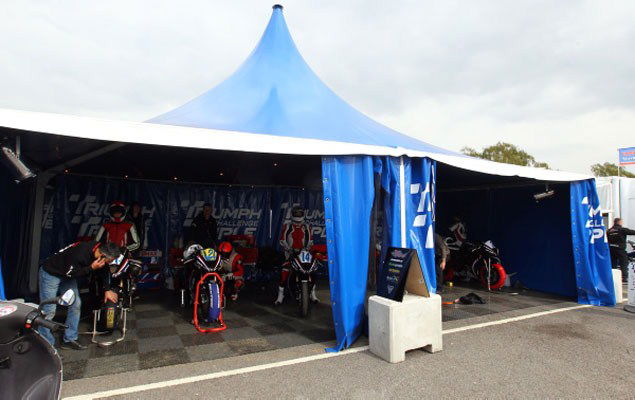
Talking of tea: over a well deserved cuppa in the back of my van, I think to myself: ‘What would a proper racer do now?’ Twenty minutes later, I’m back in the van, sipping a cold cuppa, but happy in the knowledge my suspension’s been setup by the Triumph Triple Challenge on-hand suspension guru, Perry from HM Racing. Lap timer fitted, suspension set to stock TTC settings, and I’m good to go.
During my racing experience in the 848 Challenge, you realise racing is more about waiting than anything else and with all my spannering done and dusted by lunch, our Free Practice session – the last session of the day – seems a long way off at 16:35.
Time can drag in the paddock and sod’s law dictates you’ll kill two hours doing nothing and then with five minutes to go you’ll realise you’ve forgotten to do something quite important, like swap a tyre or refuel from the last round. Gentle nerves and light-hearted banter can quickly descend into full-blown panic. I’ve experienced that plenty of times in my short racing career.
My first experience riding the TTC Daytona 675 is taking it to scrutineering, a heady 200 metre run, where you spend your time trying to avoid dozy BSB fans who consistently look surprised they’re having to move to the side to make way for oncoming motorcycles. I think they think they’re bimbling down the aisle at ASDA and not in the paddock of a racing event.
The Daytona feels sluggish as I pull away from the Triumph tent to head towards scrutineering and while parked at scrutineering, I realised there’s a good reason for that; it’s in 2nd, not 1st. Which means it’s running a race-shift pattern, 1 up and 5 down, not 1 down and 5 up. Oh dear.
My brain and race-shift work well all the time I’m thinking about what my left foot’s doing. As soon as an ounce of concentration goes to another task, like braking, my left-foot reverts back to road-shift and that’s when things get interesting. Or dangerous. Depending on the way you look at life.
Not wanting to make a challenging weekend downright ridiculous, I ask the TTC organisers if we can switch things around. My limited technical knowledge leads me to believe this is just a case of undoing a few bolts and locating a part that’ll rotate by 180-degrees, rotating it then doing the bolts back up and bingo, we’re home and dry.
With five people crowding around my bike, offering advice, you realise the TTC atmosphere is a little different to the majority of the BSB paddock; everyone’s in it to help each other out. My down-for-down and up-for-up issue hadn’t been encountered before, it seems, so plenty of head scratching ensued.
Luckily, I was loaned the support of Curly, a mechanic for the 777RR Supersport team, who also run Daytona 675s. Curly works his magic on the gear linkage while I showed expert and intimate knowledge of my kettle; Curly slurped on a factory cuppa while sorting out my bike. It was the least I could do. It was the only thing I could do.
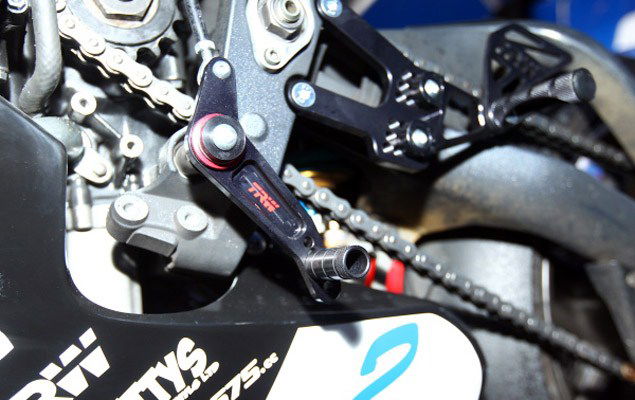
Half an hour later and we’ve got ourselves a Triumph Triple Challenge Daytona 675 with journo-spec gearbox. What did I tell you about killing time and then realising you’ve got something important to sort out? Exactly.
A I leave the pits and head down The Avenue - which is a rather quaint name for a bit of tarmac that would cause my eyeballs to swell when I went down it at something approaching race pace - I change from 5th to 4th, to nothing. I try again for 3rd, still nothing, look down and note the absence of a gear lever. I head along Lakeside in 4th, have another look and see the gearlever doubled-back under my footpeg. That’s not exactly going to help.
Any chance of following one of the other lads round evaporates as I roll on in 4th. I carry on and see if I can string a lap together. Our FP has been halved from 20 minutes to 10 - that’s five laps, max, and I need all the time I can get, so I don’t bother coming in to try and fix it.
Making the most of the wealth of torque the tiny Triumph motor packs - I press on. At points I'm much slower han the bikes firing past me and at other points, I’m amazed at how long a mono-geared Daytona hangs on to its multi-geared rivals.
My laps are steady and smooth, my clutch slipping is frantic and often. Making up for my lack of straight line speed I leave my braking to later than what I consider to be late and carry more corner speed than I think is sensible, but the Daytona doesn’t protest. The bike drops into corners with little to no effort; it seems to know its way around Oulton better than I do. Four laps come and go like that, I pull into the pits happy to have got the first session out of the way, but frustrated I couldn’t get the most from it.
Looking at the time sheets, I expect to see my name at the bottom of the time sheets - in a different league to everyone else - but I'm not the slowest and not as far off the pack as I thought I would be.
Curly gets to work and switches the linkage for one from a Fireblade and try as we might, we couldn’t get the lever to flip-under, even with the most lead-footed gear change. Job-jobbed as they say.
That's my day over, we're not out until tomorrow. Told you racing was a lot of waiting.

Qualifying at 12:15 means you can have a mega lie-in, something you’d be doing anyway on a bank holiday Sunday if you weren’t racing but when it comes to racing in a BSB support series, not being first or last out is a rare treat. Hit that snooze button.
I'm super-relaxed for qualifying; the Daytona 675 isn’t a bike that’s out to bite you and unlike the bigger bikes, a lap doesn’t feel like you're having to arm wrestle someone twice your size.
Everything about the bike feels good on the out lap, the novelty of gears means I have to think about what gear I’d need to be in, not what gear I wished I could be in.
Crossing the line after the out lap, with the tyres nicely up to temperature I start the push, squeezing the throttle without remorse, carrying more and more front brake into corners. Everything feels like it's slotting into place. Despite my lack of time on the Daytona, it fills me with confidence.
Just three corners in to my first flying lap and all that changes. Driving out of Cascades the bike hesitates, then surges forward, then hesitates; I'm running out of fuel. Or am I? I back off, hand in the air and prepare to leave the track. I roll on again and the engine feels crisp. I'm not in a hurry to pack it in, so I wind it back on.
So far, so good. I don't have a problem through the middle section of the track, no stuttering, and no coughing or spluttering but as I drive up Clay Hill it happens again. Perhaps it's the chain slipping on a worn sprocket? At that speed, on that corner, I don’t have enough spare brain cells to work it out but I do figure out it's happening at high revs, so I change up as soon as the engine even hints at hesitating. We cross the line in 1m53.8, my fourth lap of the circuit and six seconds quicker than I’d managed with just the one gear the day before.
Each lap gets harder as the engine problem starts to rear its head more often, I stay out, out of pure bloody-mindedness, hoping I can push harder where the bike allows and manage the lack of drive where it doesn't.
The hesitations start to come in lower down the rev range and after three laps I call it a day and come in. Tony Scott, the series organiser meets me at the entrace to pit lane and tells me what I wanted to tell him before I’d even had a chance to open my mouth: ‘The bike’s misfiring, I can hear it’ he says. We're both disappointed. I badly want to get back out, but in the moments where we talked about our options, rain starts to pepper my visor and I knew all chance of a decent laptime were in the process of being washed away.
I never bettered my first flying lap of 1:53.8, it puts me one from the back of the grid and a massive eight seconds off pole. Not that I would have ever got near pole but four seconds off would have seen me 10th on the grid.
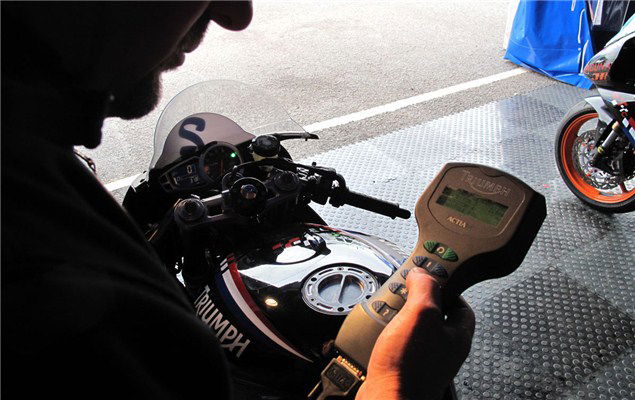
Back at the Triumph tent, Curly and Tony set to work. Off comes the fuel filter, coils, leads – they all get changed. Pete Ward, a Triumph test rider and runner-up in last year’s Triumph Triple Challenge, is here to help me out this weekend and puts his money on the coils. Whatever it is, I'm reassured it'll be a simple fix.
With everything swapped over, the bike gets run on the dyno and the problem rears its head again. The can-do attitude in the Triumph tent doesn't falter at the thought of taking the bike to pieces again. I feel like an imperial spanner in a box of metric nuts; I have the least amount of knowledge of the bike and questionable mechanical ability, so I wish the ensemble luck and make a swift exit.
I walk the track with Pete Ward and Bob Collins - both hugely experienced riders, with a Superstock 1000 Cup championship each. You don’t get one of those by being a bit average like me.
It’s incredible just how much you learn when covering ground at a tenth of the speed. What stands out the most to me is the intimate knowledge and precision that Pete applies to a lap; we're not talking about what gear to be in or where to brake, we're talking about which one of the 20 painted sections of the apex to put your front wheel on. I consider it a good corner if I get within a foot of the apex but Pete takes it to another level with the sort of precision that would make a Japanese production line look like a midnight queue in a kebab shop.
Bob, I’m not so sure about: he just goes very fast everywhere and that seems to work very well indeed.
There’s so much Oulton flying around my head. I've seen it from every angle today and after a couple of bottles of Leffe, a 1:50 seems plausible. I’m convinced it’s not the beer talking. Tomorrow, I'll do it.
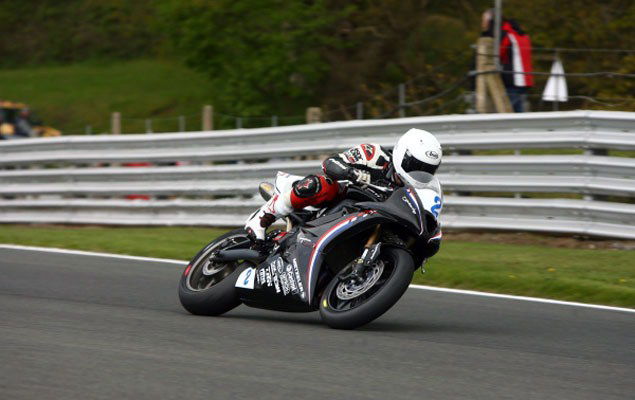
It doesn’t seem worth getting out of bed for an eight minute warm-up session but that’s exactly why I’m stood in the Triumph tent clutching a towel and a toothbrush at 7am. I’m met with a beaming smile from Paul one of the Triple Challenge organisers: the bike’s fixed. They sorted it. With the warmers on, I take a cold shower and with the worry of learning the track swept aside, I relish the thought of a few laps with a full-fat 675 and not a Daytona 450.
Full-fat is not what I get. For a lot of the lap I get a Daytona 675 but for some of it, I get the Daytona 450. The problem hasn’t been fixed.
It’s normal to lap slower in warm-up, after all, why would you push when there’s nothing to gain? With Pete’s pointers in my head, I ignore the engine-woes and concentrate on trying to hit as many of his marks as I can remember. I get three laps in before the session ends and they feel so much easier than the ones I’ve done before.
The bike seems to be where it needs to be, I’m not wrestling it over to get to an apex or gripping the bars to keep it on line. To feel more comfortable with the lap was one thing, to go half a second quicker than in qualifying was like finding a fiver in the pocket of an old pair of jeans: a proper result.
I could feel the frustrations back in the Triumph tent. Tony Scott the series organiser and Curly, the 777RR mechanic set about the bike with one more trick up their sleeves.

It turns out that the spark I caused when wiring up my laptimer fried the ECU. I feel the weight of all the problems I’d had smack me in the face. Followed by feeling like I’d been punched in the stomach after all the effort the guys had been to. I knew the battery had sparked and as soon as it did, I turned the ignition on to see if the bike fired up, it did, so I forgot all about it.
All my problems out on track were down to my questionable ability behind a spanner but even I didn’t think I’d mess up my whole weekend executing the simplest task in the clumsiest fashion.
With the ECU changed, I have a very healthy Daytona 675 indeed. A shame then that I don't get to try it out before the first race.
An even bigger shame that one of the curious side effects of a dodgy ECU was that it felt like I had a very primitive traction control system. When I got hard on the gas it chirped in as the 675 struggled to fire on all three.
Ironic then - or just plain sod’s law - that the heavens open 20 minutes before our first race. The ‘traction control’ that had been holding me up until now, could well have come in handy for these conditions. Well, maybe.
With not a lot of time to fit wets, let alone hook up the tyre warmers, a flock of 675s head out for their warm-up lap. Me included. Two riders at the sharp end of the grid collide on the second to last corner of our very-wet-indeed (luke) warm-up lap, meaning a finish would earn me a point. Thinking you're in the points is always a good way to keep yourself calm.
With a good bike underneath me, I think long and hard about the start, not wanting to make the classic mistake many a biker has made leaving the tyre fitters and giving it a big handful only to end up on their arse at 6mph. So, given my weekend so far, I opt for a steady start. From the back of the grid I can see the lake forming at the first corner. With the red light on, I pick up the revs and make a concious decision to steer well clear of the first corner lake.
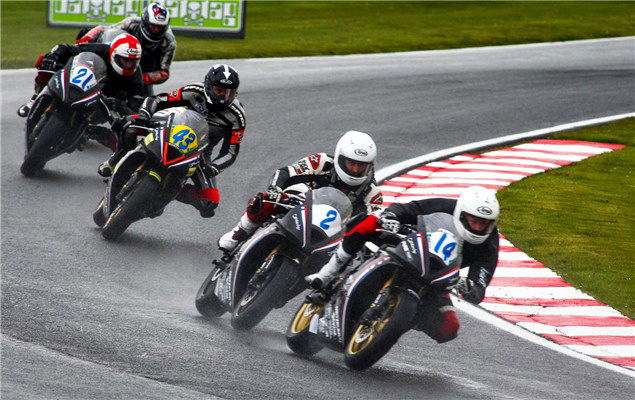
With my heart pounding in my chest, I get a steady start, some of the riders plough through the lake, I follow them through with the same trepidation as the first time I hurled myself off the high-diving board at school. A true leap of faith.
Everyone makes it through. My drive down the hill is good, earning me a couple of places, I steal another one on the brakes, braking hard but concious of the front folding. I can feel the tyres moving around underneath me, but it isn’t any different to one of those summer Sunday rides where you get caught up in the most intense rain shower and have to balance cutting a dash home to save yourself a soaking, with actually getting home in the first place. A little bit of cautious speed.
Just over halfway ‘round the first lap and I’ve picked up five places, my confidence in the conditions is growing. Firing along the straight approaching the Knickerbrook chicane, the spray from the bike in front of me gets channelled straight at my visor. This all feels about as sensible as taking a convertible through an automatic carwash.
I can barely see anything but know I need to brake harder than I have all lap. I squeeze as hard as I dare, all the time expecting the front to fold, but it sticks. As we approach Clay Hill, the fast uphill left-hander, I feel apprehensive for the first time; it’s scary enough in the dry. There are three bikes infront of me as the leaders fire over Clay Hill.
Before I know it I’m sucked into the same funnel everyone else is, I aim for the P of Pirelli on the bridge above, just like I did in the dry, I think to myself ‘Is everyone really full throttle over here?’ I doubt they are and roll the throttle just before the bike goes light at the crest. It turns out everyone was flat through there, as the group of three ahead pull a decent gap on me.
As we enter Druids, the tarmac is split down the middle. The right hand side in the part you want to be on, the left, as Pete pointed out to me, is bumpy and has less grip. As I tip in, I realise I’m going a touch too fast and about to head over the seam in the tarmac to the left-hand side where I really don't want to be. I dial in a bit more lean to hold me on line but I’m asking too much of the rear. It gently, but quickly breaks away and before I know it I’m chasing my 675 into the gravel, ungracefully.
Standing at the side of the track I get plenty of time to reflect on the moment I didn’t get away with. Why did I go in so hot? Clearly I knew the right hand edge of the tyre wouldn’t be up to temperature, couldn’t I have waited another lap? The fact is, all the times I doubted what the bike could do on the first lap, it proved me wrong and just when I was starting to get confident in what it could do, I pushed it too far.
I never have an average weekend racing; it’s either great or rubbish. You’d think this one would go down as one to forget, but despite my poor performance on track, it's one to remember for so many reasons. The atmosphere in the Triumph tent is a rare thing in the BSB paddock; everyone wants to beat the next man, but at the same time, no-one wants to see anyone left behind. Even if they are as clueless on the spanners as I am.
